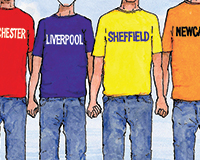Northern cities must balance identity and collaboration
This year is set to be the year of the regions, with the government placing the North’s prospects at the core of its agenda. And the wheels are already in motion.
The prime minister’s industrial strategy green paper, which pledges a funding boost of £556m for world-class infrastructure in the Northern Powerhouse, is designed to link up the cities and towns of the North to revitalise its economy.
[caption id="attachment_872691" align="alignright" width="200"] Hiro Aso[/caption]
This year is set to be the year of the regions, with the government placing the North’s prospects at the core of its agenda. And the wheels are already in motion.
The prime minister’s industrial strategy green paper, which pledges a funding boost of £556m for world-class infrastructure in the Northern Powerhouse, is designed to link up the cities and towns of the North to revitalise its economy.
The government recognises that to develop a robust regional economy, cities must work together, a fact that key supporters and stakeholders of the Northern Powerhouse identified right from the start. But cities will also need to establish their individual roles and identities along with their unique position in the market. This vital piece of the puzzle is unlikely to be a priority for central government, and for this reason, it is northern cities themselves that will be responsible for creating their own identity, vision and cultural legacy.
In Leeds, York and Manchester, we are working with key stakeholders to help them establish their identities. We have seen first-hand that when foreign investors look to the Northern Powerhouse, they are not only interested in investing in cities with genuine potential to grow, but also cities that offer a vibrant community – connected, resilient, inspiring and healthy.
Gensler’s work as principal architect on the Leeds Station Masterplan seeks to demonstrate how infrastructure can fuse historical identity with future vision to create unique and dynamic places. Tapping into the routes of the station’s Victorian heritage, we are incorporating features such as the original train arches into a 21st century design and looking at how we can use the river that runs through the city as part of the masterplan. The significance of the River Aire, which has historically divided the city in two, is widely unknown – “Leeds” is in fact derived from an old Celtic word for “fast flowing river”.
In Leeds, our masterplan must help the city meet its ambitions to make its station a key national landmark and a pivotal regeneration and economic driver for the city and region. This vision is shared by all key stakeholders involved in the project, namely Transport for the North, Northern Powerhouse Railway, HS2, Department for Transport, London and Continental Railways, West Yorkshire Combined Authority and Leeds City Council.
Delivering for a community must not come down solely to constructing anew. It is also about taking a hard look at our existing systems as well as structures and giving our rich heritage a fresh lease of life.
To reach their full potential, Northern Powerhouse cities need to take these long-term aspirations beyond politics into reality. They can learn so much from each other and from working together, rather than looking towards major centres such as London.
We see the next generation of northern cities as a community of neighbourhoods, embracing their roots and inspired by a creative and nimble spirit. It’s an exciting time to be at the epicentre of this new movement, creating history through design, the value of which will be felt for years to come.
Hiro Aso is the infrastructure practice lead at Gensler











